 |
 |
 |
| |
Patterns of Sex and PrEP in Harlem MSM: A qualitative study (HPTN 067) [Stigma/adherence/Sex]
|
| |
| |
- "the intersection of sex and prep in Harlem"
Reported by Jules Levin
IAS 2015 Vancouver July 19-23
Julie Franks1, Yael Hirsch-Moverman1,2, Avelino S. Loquere Jr1, K. Rivet Amico3, Bonnie J. Dye4, Laura McKinstry5, Robert M. Grant6, Sharon B. Mannheimer7,1,2
1ICAP, Columbia University Mailman School of Public Health, New York, New York, United States 2. Department of Epidemiology, ICAP, Columbia University Mailman School of Public Health, New York, New York, United States 3. Department of Health Behavior and Health Education, University of Michigan, Ann Arbor, Michigan, United States 4. FHI 360, Durham, North Carolina, United States 5. Fred Hutchinson Cancer Research Center, Seattle, Washington, United States 6. Gladstone Institutes, University of California, San Francisco, California, United States 7. Department of Medicine, Harlem Hospital Center, New York, New York, United States
Webcast You Tube
https://www.youtube.com/watch?v=whTpyt5L1-c
In summary, participants valued PrEP and frequently incorporated it into existing prevention strategies
Disclosing PREP use led to stigmatizing attributions as either HIV-infected or as sexually promiscuous. While participants described successfully countering this type of stigma in conversational settings, in the context of taking sex-dependent doses, anticipated or experienced stigma created significant barriers to adherence.

IAS: PrEP, Sex, and the Paradoxes of Prevention: Qualitative data from a cohort of New York City MSM participating in HPTN 067/ADAPT [Harlem, NY, USA] - (07/27/15)

Our qualitative sub-study included 6 FG and 6 individual, in-depth interviews, two per study arm, with a total of 37 participants
We conducted the FGs and Interviews using semi-structured guides that explored experiences with PrEP, including how others viewed PrEP use, and adherence challenges.
The qualitative sample mirrored the overall study sample in demographic characteristics.

We coded our verbatim transcripts using an open ended, iterative approach to develop themes, and today I will be showing how these themes fit together, along with sample quotes that illustrate the themes. The tables I will show also list the dosing arm the speaker was assigned to: daily, time-driven, or event driven as described in preceding presentations.

Our participants saw PrEP as a significant improvement over existing prevention tools, using phrases like "wonder drug," and "superman pill." Many described the psychological value of PrEP, that it lessened fear and anxiety about contracting HIV risk. One participant said that PREP was like his big brother standing by to protect him from the "bully in the schoolyard" that is HIV. Becoming more aware of the need for prevention was a common experience. Several participants articulated the importance of a combination prevention strategy that included both PrEP and condoms.
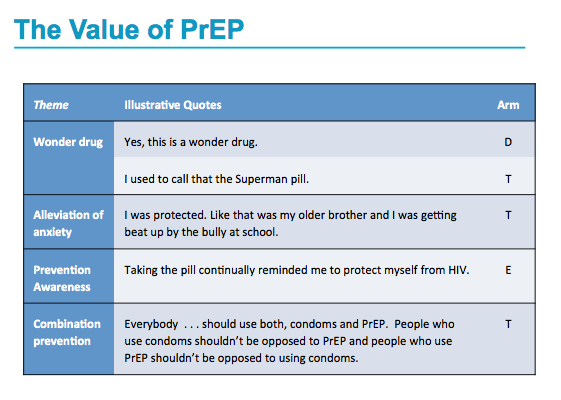
Despite the overall high value they placed on PrEP, participants used the word stigma very frequently to describe the attitudes of others.
Disclosure of PrEP use invited two distinct types of stigma
First, stigma attached to HIV medications led to the PrEP user being perceived as HIV-infected. Several participants expressed that no matter what they told someone about prep, all that person would remember is "HIV". "You say you are taking it to prevent HIV, they think you are taking it to treat HIV." This was very frequently expressed.
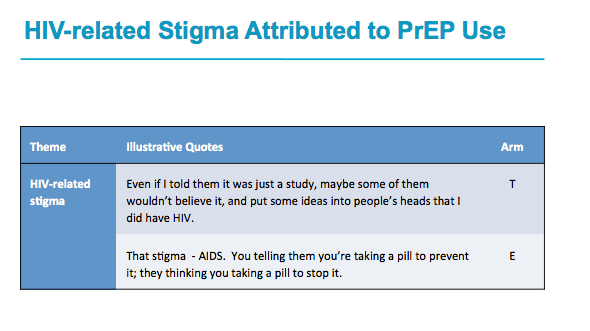
The second type of stigma was attached to PrEP as an innovative prevention technology that labelled the user as exceptionally promiscuous or unusual in someway that merited caution. This kind of stigma was frequently expressed in the form of questions - "what does this mean . . .?" "Are you putting me at risk?" "What are you taking pills for?" implying that PrEP is a reason to investigate the user more deeply than had been done before.
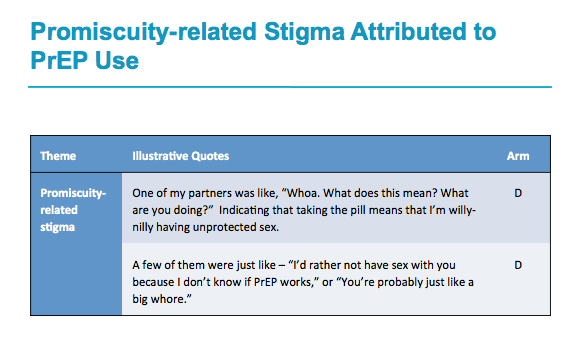
Participants described effectively countering misconceptions and stigmatizing attitudes about PrEP in many conversational settings - Insisting to providers that they would be an appropriate candidate for PrEP, educating family members about reasons for joining the study, and addressing friends' misconceptions
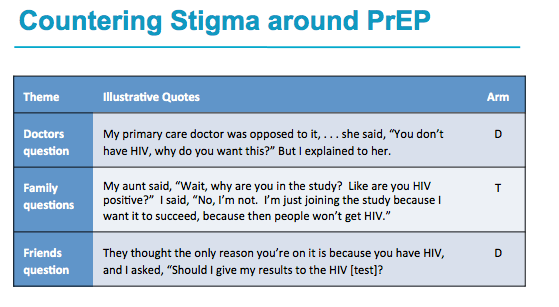
However, in the context of sexual encounters, stigma attached to PrEP limited participant's ability to adhere to doses taken around sex. Participants described both experiencing and anticipating such stigma. Several described pill-taking in the context of sex as "awkward" - "It would spoil the mood" - for others, disclosing PrEP use caused sexual partners to break off the encounter. One participant, talking about the need to be discreet, implicitly connected PrEP use to the potential for HIV transmission in a sexual encounter, which some people resist acknowledging.
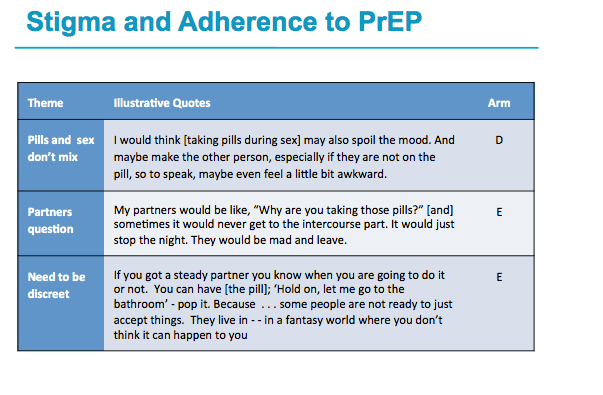
This research has some limitations.
Qualitative participants were a convenience sample that does not represent all our study participants or other PrEP users; our findings are not generalizable.
Also social desirability bias may have limited participants' willingness to share some experiences and opinions, so the findings cannot be construed to represent the full range of our participants' experiences

|
| |
|
 |
 |
|
|